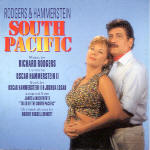South Pacific was one of the longest running musicals on Broadway. As a music “drama” it was instrumental in changing the course of musical theater, guiding it ever more toward dramatic and topical themes. The original cast recording is a legend and has just been re-issued by Sony using a handsome 20-bit SBM master. Why, then, one might ask, do we need another recording? Well, for one thing, any show that has had as much dinner theater and revival exposure as this one certainly can take another interpretation. For seconds, this is a recording in Jay’s Master Works Edition series, which means that the entire musical score is presented, right down to the last underscore, entr’acte, and exit music. That’s why most Jay editions take two CDs, one for Act I, the other for the second. No other recording of the show comes close to including this much of the score.
Not content with being just complete, producer John Yap has scoured the globe for an excellent cast. Most of the principals have starred in successful revival productions as geographically far apart as New York, Long Beach, and Australia! Paige O’Hara makes a perky Nellie Forbush, a really believable and likable “cockeyed optimist”; Pat Suzuki is a solid and warm Bloody Mary, who brings warmth and seductiveness to “Bali Ha’i”; and Sean McDermott plays a virile Lt. Cable, giving a powerhouse rendition of “You’ve Got to be Carefully Taught”. The other singers, as well as the chorus, are absolutely first rate. The only weakness in this energetic cast is opera star Justino Diaz, who has the right timbre of voice for Emile De Becque but sings a little off the pitch some of the time–not enough to be disastrous, but sufficiently so to make “Some Enchanted Evening” a bit less than that.
The orchestra is the best on any recording of this show, and conductor John Owen Edwards, who helms most Jay recordings, seems to know this music like the back of his hand. Last but not least is the compatible Dolby surround sound, which gives incredible body and realism to all the performers, particularly the singers, who have a genuine presence not usually found on souped-up cast recordings, which usually rely on entirely too much reverb. Operas should be lucky enough to get a recording like this.
































